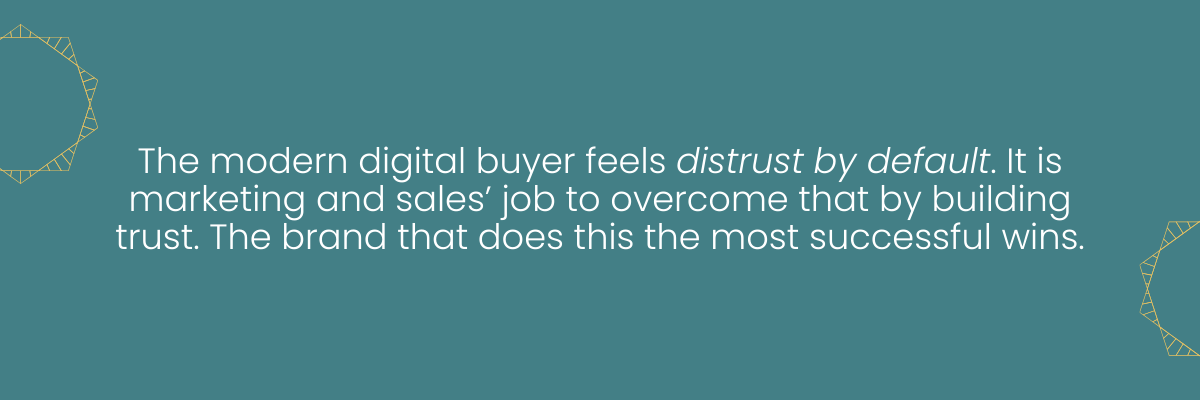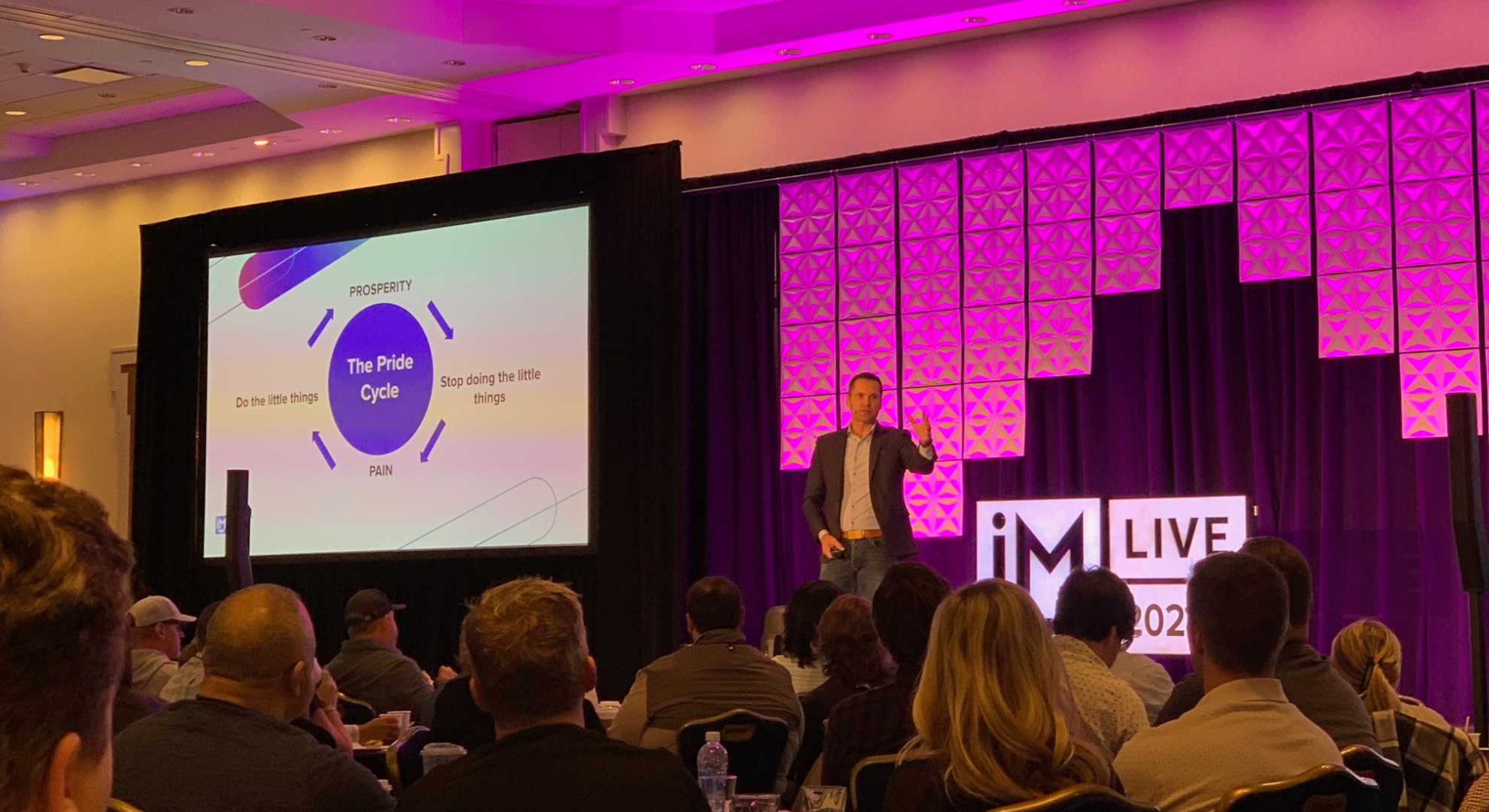10 Marketing & Sales Objectives To Track To Become The Most Trusted Voice In Your Space
Whether you are a donut shop down the street, a child care center, a cyber security software provider, or a construction company, our customers must feel a high enough level of trust towards us that they are willing to exchange money for our product or services. In other words, trust has always been and will always be essential to our business. I think we can all agree to that.
Yet when I speak to business leaders about their goals, it becomes apparent that not many consider as trust something we need to actively track towards and work on. They treat it more as if if happens as a side-product of the other things we do as a business.
In this article, I will recommend ten key performance indicators that you should start measuring to measure how well you are doing building and nurturing trust with your customers. By the end of the article, you will not only know how those KPIs contribute to your marketing strategy and but be able to explain the importance to your management.
Marketing & Sales Objectives Covered In This Article:
- Increase Quality Content Engagement
- Better Lead Quality
- Higher Conversion Rates
- Lowered Customer Acquisition Cost (CAC)
- Increased Repeat Business & Customer Lifetime Value (CLV)
- Contracting/Shorten Sales Cycles
- Reduce Percentage of Lost Deals/Sales
- Customer Testimonials and Reviews
- Referral Rates
- Customer Feedback and Interaction
Why Trust Is Now More Important Than Ever
Have you ever noticed that, as a buyer, you are now much more distrusting of anyone trying to sell you anything? As buyers we often feel a company doesn't have our best interest at heart, is hiding something because they aren't being transparent (e.g., on price), and won't deliver on a promise or really solve my problem.
To counteract that feeling, we:
- Do a lot of research online/due diligence (comparisons, reviews, pricing)
- Requests multiple quotes / shops around
- Doesn’t trust sales people and prefer seller-free buying
Despite having more choices than ever available to us, we are wary of making costly mistakes. We want to feel empowers and in control when buying, we are often impatient and move on quicker if we can't find what we are looking for.
In other words, the modern digital buyer feels distrust by default (in fact, "55% of US and UK consumers say they trust brands less than they did in the past, according to Hubspot) and it is the company's job (marketing and sales) to overcome that and build trust. The brand that does this the most successful wins.

This is the exact reason why the ultimate goal of They Ask, Your Answer is to become the most trusted voice in your space. We coach our clients how to do exactly that as part of their They Ask, Your Answer Mastery journey. So, let's dive in and look at which objectives will help you get there.
Your Marketing & Sales Objectives Need To Be Directly Tied To Revenue & Business Goals
In a lot of smaller and mid-size organizations I work with, the business owner, founder, or CEO (who often has run the company for many years) will task their marketing team with specific goals. Often they look like this:
- Brand Awareness
- Demand Generation
- Market Share Growth
- Improving Brand Image
- Customer Satisfaction and Loyalty
But here is the problem. How exactly does "Brand Awareness" help you achieve your revenue goals? How does an "Improved Brand Image" enable you to achieve the increase in sales you need?
Instead of handing down marketing goals, define your marketing and sales goals as revenue team objectives which must be based on the holistic business, revenue, and sales goals. This way, your marketing and sales objectives are directly tied to helping the business achieve the overarching business goals.
Please note: For simplicity and readability, I will refer to these shared marketing and sales objectives that are tied directly to revenue and business goals as marketing objectives.
So, what do well-defined objectives look like? I am glad you ask. A useful objective defines the goal you are trying to achieve. It should be clearly defined using the SMART approach:
- Specific,
- Measurable,
- Attainable,
- Relevant, and
- Timely.
Further, a marketing objective is different from a Key Performance Indicator (KPI). A KPI is the metric you will measure and track over time to determine if you are on track to achieve your objective. Often, one objective will have multiple KPIs contribute to it. So, an objective is the goal you are working towards, a KPI is a metric that helps you measure your progress.
#1: Increase Quality Content Engagement
What Is It?: This objective focuses on increasing the interaction and engagement of your audience with your content, like articles, videos, YouTube Shorts, and social media posts. However, this is different from your traditional vanity metrics (e.g., number of followers and views) as this objective primarily hones in on how well we build our audience and how our content resonates with them. In other words: do we create helpful content our ideal buyers engage in?
Why It Is Important?: Increased engagement indicates that your content resonates with your audience, establishing your brand as a valuable and trusted source of information. It's a sign that customers find your content relevant, useful, and worthy of their time.
KPIs To Track:
- View time per video/ read time per article
- Number of shares and likes per post
- Number of quality comments per post
- Click-through rates on content-related calls-to-action.
#2: Better Lead Quality
What Is It? This goal aims to attract more qualified leads who are more likely to convert into customers. It’s about focusing on the relevance and potential of leads rather than just their quantity.
Why It Is Important? Higher quality leads imply that your marketing efforts are successfully targeting the right audience who trust your brand to solve their problems or meet their needs. This alignment increases the likelihood of conversions, signifying effective and trusted communication.
KPIs:
- Lead conversion rate (percentage of leads that become customers).
- Rate of leads progressing through the sales funnel stages.
- Customer acquisition cost for converted leads.
- Average lead score based on predetermined qualifying criteria.
- Percentage of leads generated from trusted sources or referrals.
#3: Higher Conversion Rates
What Is It? This marketing objective measures the percentage of prospects who take a desired action, such as making a purchase, signing up for a newsletter, or downloading a whitepaper. As the quality of your content improves, your readers, viewers, and visitors will become see you as the trustworthy expert in your field, resulting in them becoming more willing to download a lead generation offer, submit a form, or schedule a call.
Why It Is Important? Improving conversion rates indicates that your marketing and sales strategies are effective in building trust and persuading prospects to commit. It's a direct reflection of how well you've established trust and met the needs or desires of your audience.
KPIs:
- Overall conversion rate (# of conversions divided by the total # of visitors).
- Conversion rates by marketing channel (identifying which channels build the most trust).
- Time to conversion (how quickly leads convert after initial contact).
- Conversion rates for specific calls-to-action.
- Bounce rate on key conversion pages (lower rates can indicate higher trust).
#4: Lowered Customer Acquisition Cost (CAC)
What Is It? This objective measures the efficiency and effectiveness of your marketing and sales efforts by calculating the average cost spent on acquiring a new customer. It includes all marketing and advertising expenses divided by the number of new customers acquired over a specific period.
Why It Is Important? Lowering the customer acquisition cost (CAC) is crucial as it indicates a more efficient use of resources and a higher return on investment (ROI). It often signifies that trust in your brand has led to more word-of-mouth referrals and organic growth, reducing the reliance on paid marketing strategies. The more someone can trust your brand, the easier it is to make them a customer. On the flip side, a high (or increasing) CAC can signal distrust in your brand, products, or content.
KPIs:- Overall CAC over time.
- CAC by channel to identify the most efficient methods.
- Ratio of customer lifetime value (CLV) to CAC, indicating the long-term value of reducing acquisition costs.
- Conversion rates from different marketing channels, as higher trust can lead to higher conversion rates and thus lower CAC.
- Number of customer referrals, as an increase indicates higher trust and can contribute to lowering the CAC.
#5: Increased Repeat Business & Customer Lifetime Value (CLV)
What Is It? Repeat business refers to customers making subsequent purchases or renewing contracts, while customer lifetime value is the total revenue a business can expect from a single customer account throughout their relationship.
Why It Is Important? Increases in these areas are indicators of deepened customer trust and satisfaction. They demonstrate that customers not only believe in the value of your products or services but are also willing to continue investing in them. This loyalty is essential for sustainable growth and profitability.
KPIs:
- Repeat purchase rate or renewal rate.
- Average customer lifetime value and its growth over time.
- Time between purchases or contract renewals.
- Customer retention rate.
- Net promoter score (NPS), as it reflects customer satisfaction and likelihood to contribute to repeat business.
#6: Contracting/Shorten Sales Cycles
What Is It? This objective aims to reduce the amount of time it takes for a prospect to move from initial contact to closing a sale. A shorter sales cycle means customers are making decisions more quickly.
Why It Is Important? Shortening the sales cycle is a sign of higher efficiency and indicates that customers trust your brand enough to make quicker purchasing decisions. This can lead to increased sales volumes and better cash flow for the business. This is crucial because a confused and distrusting buyer needs a lot more education (or convincing depending on your sales approach) than buyers who trust your brand.
KPIs:
- Average length of the sales cycle over time.
- Conversion rates at each stage of the sales funnel.
- Time to close by sales channel or campaign.
- Number of interactions or touchpoints before a sale.
- Rate of return on engagement activities, indicating trust-building efficiency.
#7: Reduce Percentage of Lost Deals/Sales
What Is It? This objective focuses on lowering the rate at which potential sales fall through during the sales process. It's about identifying and addressing the reasons why deals are not closing.
Why It Is Important? Reducing the percentage of lost deals is crucial for improving sales efficiency and overall success. It suggests that your sales team is effectively building trust and addressing the concerns of potential customers, leading to more closed deals and higher revenue.
KPIs:
- Win rate (percentage of deals won vs. total deals).
- Reasons for lost deals, categorized and analyzed.
- Engagement rates in follow-up communications.
- Customer feedback at the point of sale or loss.
- Time spent in each stage of the sales funnel, identifying bottlenecks or trust issues.
#8: More Customer Testimonials and Reviews
What Is It? This goal focuses on gathering and increasing positive feedback, testimonials, and reviews from customers about their experiences with your products or services.
Why It Is Important? Positive testimonials and reviews serve as social proof, significantly influencing the purchasing decisions of potential customers. They reflect customer satisfaction and trust in your brand, enhancing your reputation and credibility.
KPIs:
- Number of positive reviews and testimonials received within a specific period.
- Average rating on review platforms (e.g., Gartner Peer Reviews, Trustpilot).
- Percentage of 5-star reviews.
- Conversion rate increase attributed to testimonials and reviews.
- Sentiment analysis of reviews to gauge overall customer satisfaction.
#9: Referral Rates
What Is It? This goal measures the rate at which existing customers recommend your business to new prospects through a formal or informal referral program.
Why It Is Important? High referral rates indicate that your customers not only trust your business but are also willing to stake their own reputation on the quality of your products or services. Referrals can significantly lower acquisition costs and increase the quality of incoming leads.
KPIs:
- Number of referrals received per customer.
- Conversion rate of referred leads.
- Lifetime value of referred customers compared to non-referred customers.
- Percentage of customers participating in referral programs.
- Growth in referral program participation over time.
#10: Customer Feedback and Interaction
What Is It? This objective focuses on increasing and improving the two-way communication between the business and its customers, including soliciting feedback, answering questions, and engaging in public forums.
Why It Is Important? Active engagement and responsiveness to customer feedback and questions demonstrate your commitment to customer satisfaction and continuous improvement. It builds trust by showing that you value their opinions and are accessible.
KPIs:
- Volume of customer feedback and interactions over time.
- Response time to customer inquiries and feedback.
- Customer satisfaction score (CSAT) post-interaction.
- Number of issues resolved through customer feedback.
- Engagement rates on social media and other public forums.
Depending on your business and industry, choose two to three primary sales and marketing objectives from the list above and create a detailed strategy on how you will achieve those. It is crucial to define what success looks like and how you will measure your progress toward achieving these goals.
I hope, this was helpful for you in defining your marketing strategy and KPIs. If you want to talk through your specific goals and get some feedback on them, feel free to reach out to me directly.
Share this
You May Also Like
These Related Stories

From Trust Out Of Necessity To Distrust By Default: How Trust Evolved Over The Last 50 Years

10 Must-Have Elements Every Great Buyer-Focused Website Has

.png?width=250&height=125&name=TrustBuilderLogoWhiteTranspBackgr(250x125%20px).png)



No Comments Yet
Let us know what you think